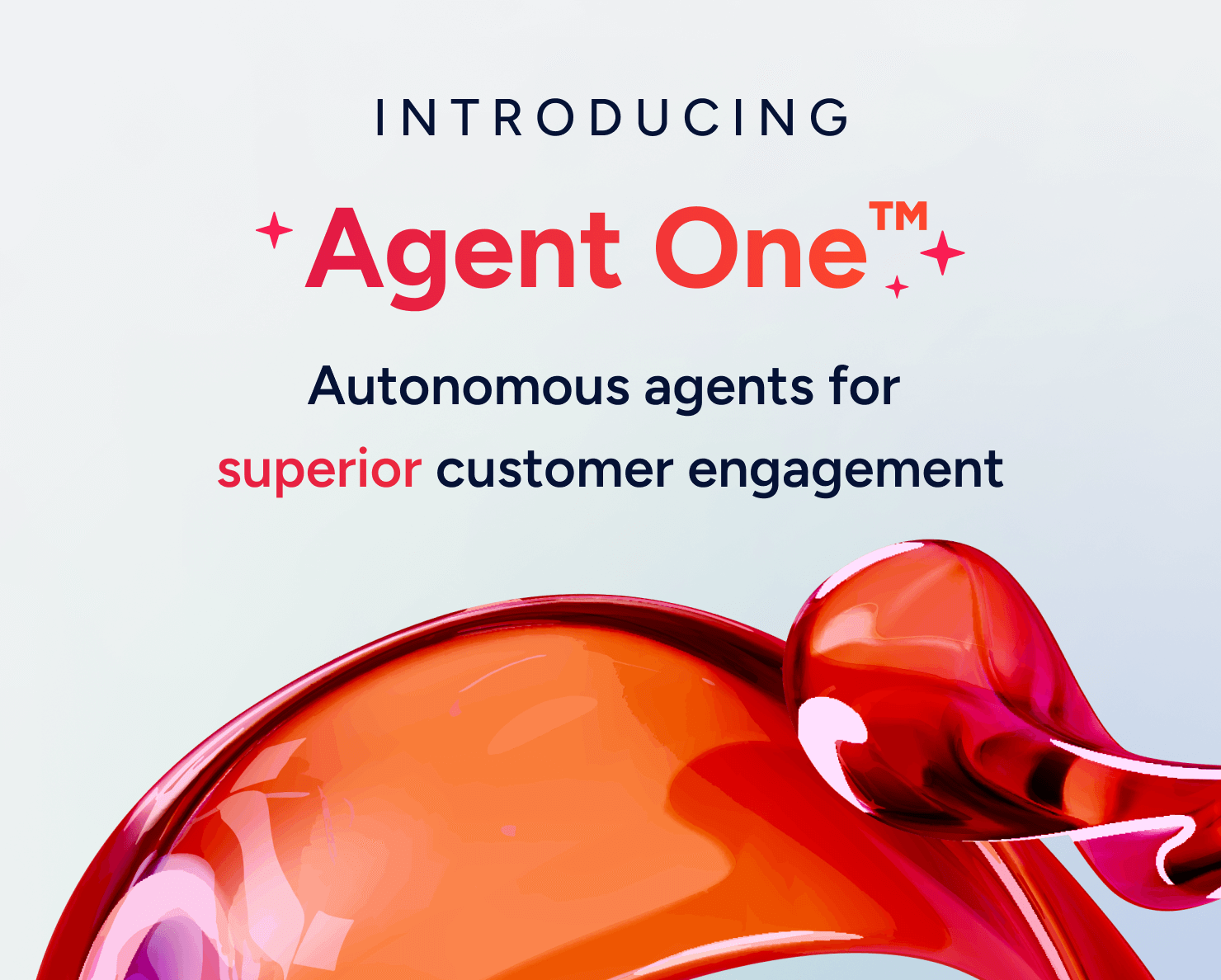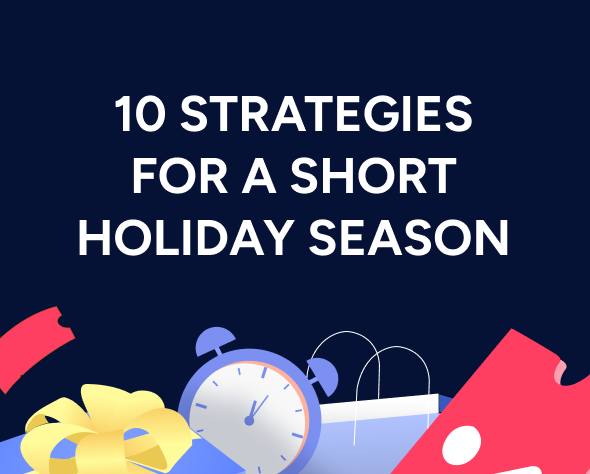What is omnichannel marketing? Examples, strategies & best practices
The term omnichannel marketing is often used to describe a marketing program that:
- Spans across different digital and sometimes physical channels, like brick-and-mortar stores or branch offices.
- Is based on a solid, data-driven understanding of the entire customer journey that gets updated in real-time.
- Delivers consistent experiences across all customer touchpoints.
Updated on 6 Mar 2024
While achieving that seemed nearly impossible years ago, today it’s expected by customers worldwide. As a result, brands must navigate complex challenges — like data silos and outdated martech solutions — to build and implement a successful omnichannel marketing strategy.
In this guide, you’ll learn what omnichannel marketing is (with examples) and how it differs from multichannel marketing. We’ll also discuss practical steps you can take to build and implement your omnichannel strategy, like data unification, segmentation, behavior analysis, and more.
Insider helps companies like Adidas, Philips, Allianz, GAP, and Lexus successfully implement omnichannel marketing across their websites and mobile apps, as well as channels like email, push notifications, SMS, WhatsApp, and more.
Visit our website or schedule a demo with our team to learn how Insider can benefit your business as well.
What is omnichannel marketing?
Omnichannel marketing is the process of bringing all marketing channels and customer touchpoints — e.g., your website, mobile app, emails, messaging channels, online ads, chatbots, and so on — together by connecting them to a central platform.
When done well, the benefits of omnichannel marketing include:
- Consistent user experiences across all touchpoints. In an ideal omnichannel scenario, customers get timely, relevant, and personalized messaging, content, and product recommendations during all their interactions with a brand.
- Increased conversion rates, revenue, and retention. When you tailor the entire experience to people’s needs, you’re much more likely to convince them to buy your products and form long-term, profitable customer relationships.
- Optimized marketing efforts and budget. Using one central platform for your marketing needs helps reduce the overall number of tools in your stack. This can drastically reduce the complexity of your marketing operations and lead to cost savings.
The difference between omnichannel marketing and multichannel marketing
The term multichannel marketing is sometimes used interchangeably with omnichannel marketing. However, they’re quite different.
A standard multichannel approach focuses solely on reaching customers on different touchpoints.
Every single channel works in isolation, and data about the customer journey isn’t being shared in real-time across the marketing stack. As a result, the brand’s messaging and product recommendations aren’t consistent which creates a disjointed customer experience and results in lower engagement.
The omnichannel approach aims to fix these issues. As we said, the whole omnichannel marketing process is built around connecting all marketing channels into a central platform. The goal of this is to gain an understanding of the entire customer journey and use that to deliver a consistent experience across all touchpoints (not just reaching customers on various channels).
For example, in a multichannel approach, a brand might offer the same products to the same customers across their website, emails, and messaging channels, even if they’ve shown no interest in the item or the category.
In contrast, an omnichannel marketing strategy would take into consideration what customers do at each touchpoint. This would affect how the rest of the journey develops enabling the brand to change its approach in real-time.

Real-world examples of omnichannel marketing
In this section, we’ll look at three companies that successfully implemented omnichannel marketing strategies and tactics. They all used Insider’s broad channel access, personalization tools, and automation capabilities to do so, resulting in improvements to conversions, revenue, and other key metrics.
Note: If you’re interested, click here for our detailed article on omnichannel marketing examples.
Example 1: Fashion brand increasing CLTV by 25%
NA-KD is a fashion brand founded in 2015 that now boasts a presence in over 50 markets.
While the brand was growing incredibly fast, they faced a challenge — their disconnected tech stack (made up of point solutions and in-house technology) couldn’t keep up with the increasing amounts of customer data and new marketing channels they were exploring.
They turned to Insider with the aim of consolidating their data and drastically improving their omnichannel approach.
The first part required using Insider’s enterprise customer data platform (CDP) — a solution built specifically to aggregate customer data and give brands a 360-degree view of all customers. These profiles gave NA-KD a deep understanding of their customers with insights into:
- Purchase histories.
- Attribute and discount affinity.
- Customer lifetime value (CLTV).
- Last browsed and abandoned products.
- Likelihood to purchase or engage on a specific channel.
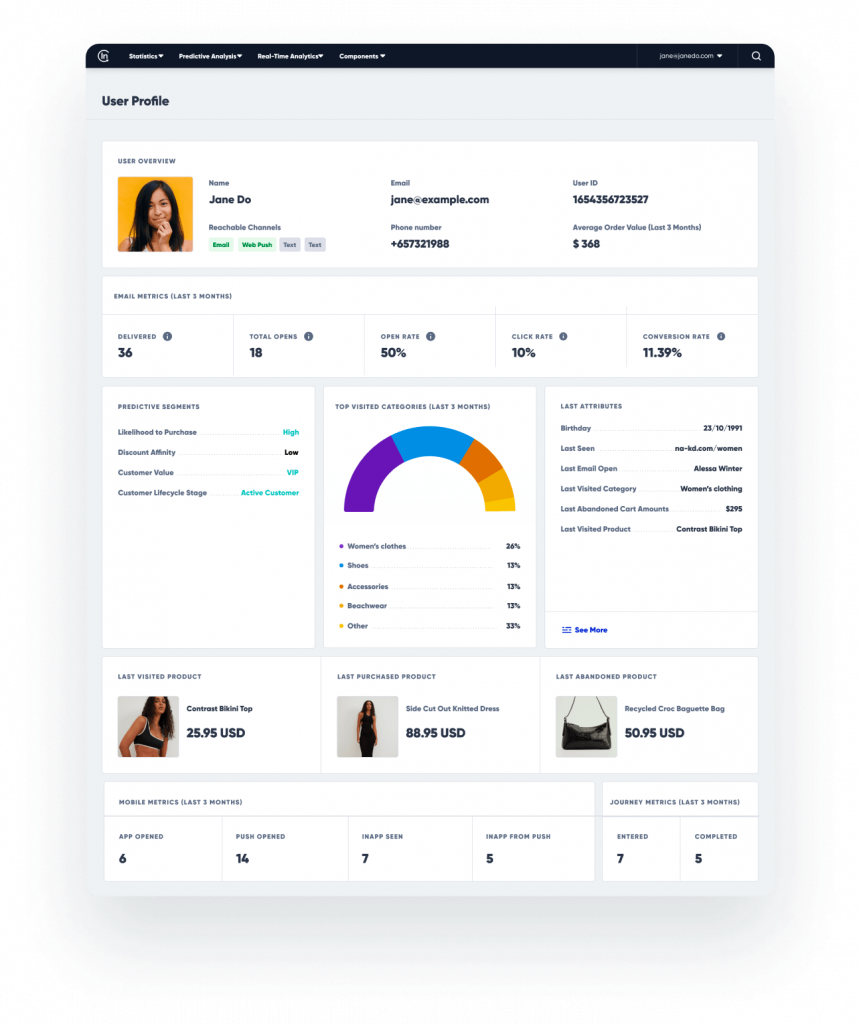
Once their data was unified, they were ready to transform their omnichannel marketing approach. Using Insider’s customer journey builder and personalization tools, NA-KD started building and automating individualized omnichannel marketing campaigns across their:
- Email and SMS communications.
- Website and mobile app.
- Push notifications.

NA-KD was able to achieve a 25% increase in CLTV and a 72x ROI in 12 months using this new approach to omnichannel marketing. You can find their complete success story on our website.
Example 2: Telco company boosts conversions by 159%
Vodafone is the largest mobile and fixed network operator in Europe. They operate in 21 countries, with over 300 million mobile customers, 30 million broadband customers, and 20 million TV customers.
The brand’s marketing team was looking for ways to test new channels and enhance their omnichannel efforts as a whole. They also wanted to increase Average Revenue Per User (ARPU), customer retention and loyalty, and conversions.
They choose to work with Insider due to our solution’s ability to reach customers across different channels — in this case, web push notifications, email, on-site, and Facebook — with consistent and timely communications.
The key here was Insider’s advanced segmentation. Vodafone was able to use 120+ ready-made segmentation attributes to target the right customers with their efforts.

This helped the brand achieve a 64% increase in lead generation and a 52% boost in conversion rates in three months.
Another key goal for Vodafone was reducing cart abandonment. They believed that many cart abandoners would only require a small nudge to complete their purchase.
Using Insider’s web push notification, Vodafone launched a campaign targeted at cart abandoners. The campaign displayed a reminder message to them while they were browsing the site, which created a sense of urgency and demand for their carts.

Here’s what the Group Head of Digital Marketing and eCommerce at Vodafone said about the results:
“Last quarter, on-site cart reminders increased conversion rates by 159% and the platform as a whole delivered more than 6X ROI.”
You can find Vodafone’s complete success story on our website.
Example 3: Retail company achieves a 356x ROI
Founded in 1958, Matahari is one of Indonesia’s largest and most recognized retail companies. They teamed up with Insider to solve a very common omnichannel challenge — bridging the gap between their digital channels and the in-person customer experience at their physical stores.
Although the brand had a website and was sending out high volumes of emails, they were generic and not personalized. Plus, Matahari customers have a unique Membership ID they can use in-store and online, but the company wasn’t using this data to power its email campaigns.
To solve this challenge, our team suggested they use our eCommerce CDP to unify their customer data and get a clear view of the customer journey. This enabled Marahari to implement precise segmentation and personalization strategies based on Membership ID data, which alone improved email open rates from 5-10% to 30% — a 328% increase.
Next, the brand’s team also used Insider to overhaul their mobile app engagement strategy. By using visually appealing, timely, and personalized mobile app push notifications, Matahari achieved much higher customer engagement and retention, leading to a 356x increase in revenue from their mobile app.

Finally, Matahari also used Insider’s journey orchestration tool (Architect) to introduce automated workflows for new members of their Membership program. The tool also seamlessly integrated with their communication channels, including the brand’s mobile app, Web Push, and API, to send automated payment notifications.

These AI-powered journeys enabled Matahari’s team to optimize customer interactions, maximizing the team’s efficiency and reducing a lot of the manual effort involved in campaign creation.
Here’s what a Senior Marketing Manager at Matahari said about working with Insider:
“By leveraging Insider’s Architect, we were able to streamline and automate critical customer journeys. The automation of first transactions, new member emails, and payment notifications has significantly improved our operational efficiency and customer experience. With the implementation of engagement segmentations and A/B testing, we achieved impressive revenue growth and enhanced customer engagement.”
You can find the complete Matahari case study on our website.
How to build and implement an effective omnichannel marketing strategy
While there’s no one-size-fits-all approach to implementing an omnichannel marketing strategy, there are three steps that lay the foundation for success for most brands:
- Getting a clear view of customers’ journeys, including purchase histories, website interactions, engagement on email and messaging channels and more.
- Analyzing customer data to uncover practical insights into what customers are interested in, where and how often they want to be contacted, what they buy, and more.
- Segmenting audiences, based on traits, behaviors, and characteristics like devices, locations, shopping behaviors, mobile app usage, and likelihood to purchase or engage on a channel.
With that foundation, omnichannel marketing becomes much easier. However, that’s still only half of the battle, as you also need to use your data, segments, and insights to create personalized omnichannel experiences.
In the sections below, we’ll look at the whole process — from unifying and analyzing your data to using it to build successful omnichannel campaigns.
#1 Reliable customer data
It’s no coincidence that two of the examples of successful omnichannel marketing we showed earlier (NA-KD and Matahari) started with customer data integration.
Without clean, reliable, and easily accessible customer data, marketers can’t get a clear picture of the buyer’s journeys or make informed decisions when building and optimizing omnichannel campaigns.
This is where CDPs are so valuable — they let you aggregate data from multiple sources into a single convenient database. They also come with built-in segmentation and analytics capabilities, so you can uncover insights and find the right audiences for each campaign.
For example, Insider’s CDP can aggregate data from CRMs, CMSs, APIs, social media tools, analytics tools, customer service software, automation platforms, and other online and offline channels. This allows our platform to create detailed, 360-degree profiles of all your customers that contain key insights like:
- The customer’s name, demographics, and contact info.
- Predictive characteristics, like likelihood to purchase or engage.
- Behavioral data, like interactions with your website or messaging channels.
- Last purchased, visited, and abandoned products.
- And other key characteristics and metrics.
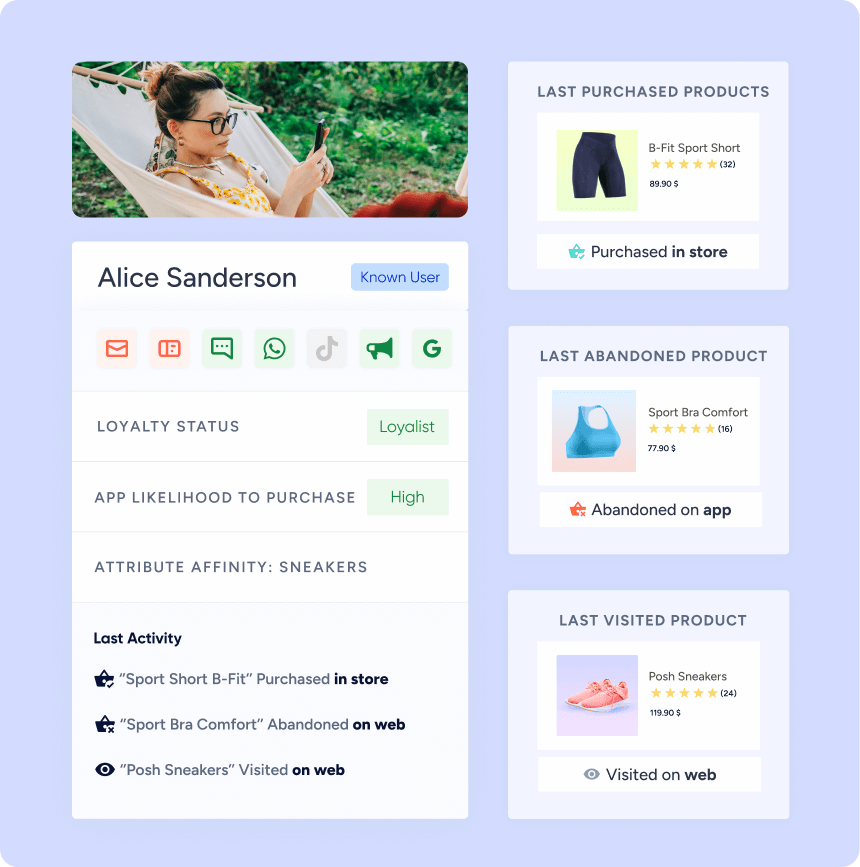
These profiles contain everything your brand needs to create personalized customer experiences and omnichannel campaigns. Insider’s CDP also comes at no additional cost, so you don’t have to pay extra to consolidate your data and get a clear view of your customers’ journeys.
Finally, our Integration Hub offers native integrations for all sorts of tools, platforms, and solutions. This means you can set up Insider’s CDP to share data in real-time with:
- eCommerce platforms, like Shopify, VTEX, and Akinon.
- CRMs like Salesforce, HubSpot CRM, or Microsoft Dynamics CRM.
- Marketing automation tools, like Adobe Marketo, Keap, and Oracle Eloqua.
- Email marketing platforms like Mailchimp, SendGrid, and Campaign Monitor.
- Data warehouses and storage systems, like BigQuery and Amazon S3.
- Ad networks, like Google, Facebook, and TikTok ads.
- And many other SaaS tools.

#2 Segmentation and analytics
As we said earlier, Insider helps you home in on the right audiences for your campaigns with 120+ segmentation attributes, including traits, behaviors, and preferences. The attributes are spread across three different audience types:
- Standard, which include characteristics like locations, demographics, devices, operating systems, and more.
- Predefined, like leads, cart and browser abandoners, mobile app users, customers who’ve interacted with your brand on a specific channel, and more.
- Predictive, which are created by our AI algorithms, like customers with a discount affinity, with a high likelihood of buying or engaging on a specific channel, and more. You can check out our guide to predictive marketing for a deep dive into the importance and impact of predictive segmentation.

Insider also gives you full control over your segments, enabling you to export and target them via online ads on Google, Facebook, and TikTok. For example, U.S Polo Assn. used Insider’s predictive segmentation to only target users with the highest purchase intent with their Google Ads, resulting a:
- 311% increase in conversion rates.
- 153.03% increase in return on ad spend (ROAS).
- 58% decrease in customer acquisition costs (CAC).
Besides segmentation, you also have a plethora of behavioral analytics capabilities at your disposal. These enable you to granularly analyze how audiences engage with your brand and make customer-centric decisions for your omnichannel campaigns.
For example, here are some behavioral analytics tools you can use:
- Funnels: You can build event-based funnels based on your goals, whether that’s purchases, survey completions, email signups, event bookings, and more. The funnels will show you how users progress through each step toward the goal and more importantly — where they drop off.

- Purchase behavior analytics: This type of analysis is essential for eCommerce brands looking to understand which their top-performing products and categories are (and why). You can also find details about time to purchase and other useful insights that can help you drive more revenue with your omnichannel efforts.

- Message frequency analysis: When communicating with customers across channels, it’s essential to not overload them to the point where they become annoyed by your brand. With this feature, you can analyze how different types of customers — VIPs, loyal, inactive, and so on — interact with your messaging across every single channel to determine the optimal strategy for engaging them.

- Channel reachability analytics: Similar to the previous tool, this one analyzes how different segments engage on specific channels. This helps inform your omnichannel strategy, as you can avoid spending time and resources on touchpoints customers don’t bother with.

#3 Data activation and automation across channels
Data activation is the process of using your unified customer data to create personalized experiences that drive revenue, retention, and customer loyalty. In the context of omnichannel marketing, this involves:
- Reaching customers at different touchpoints.
- Personalizing your communications across those touchpoints.
- Ensuring all your efforts are coordinated and cohesive to create a seamless experience.
Again, a truly unified marketing platform like Insider can help you in all of these regards. For example, you can use Insider’s broad channel access to reach customers and personalize their experiences across your:
- Website and mobile app. You can personalize everything from banners, categories, pop-ups, site search results, and even Instagram-like stories. This can help you drastically improve conversion rates and maximize the budget you’re spending to get people to your site. Adidas used Insider’s web personalization suite to generate a 259% increase in average order value (AOV) from new customers in one month and a 13% increase in homepage conversions.

- Emails. Insider lets you implement both simple and complex email personalization tactics — from adding a customer’s name, birthday, and cart items to an email to extending your AI-powered product recommendations to your emails. You can use AMP emails to create interactive experiences that enable customers to mix and match products, answer surveys, make reservations, and much more.
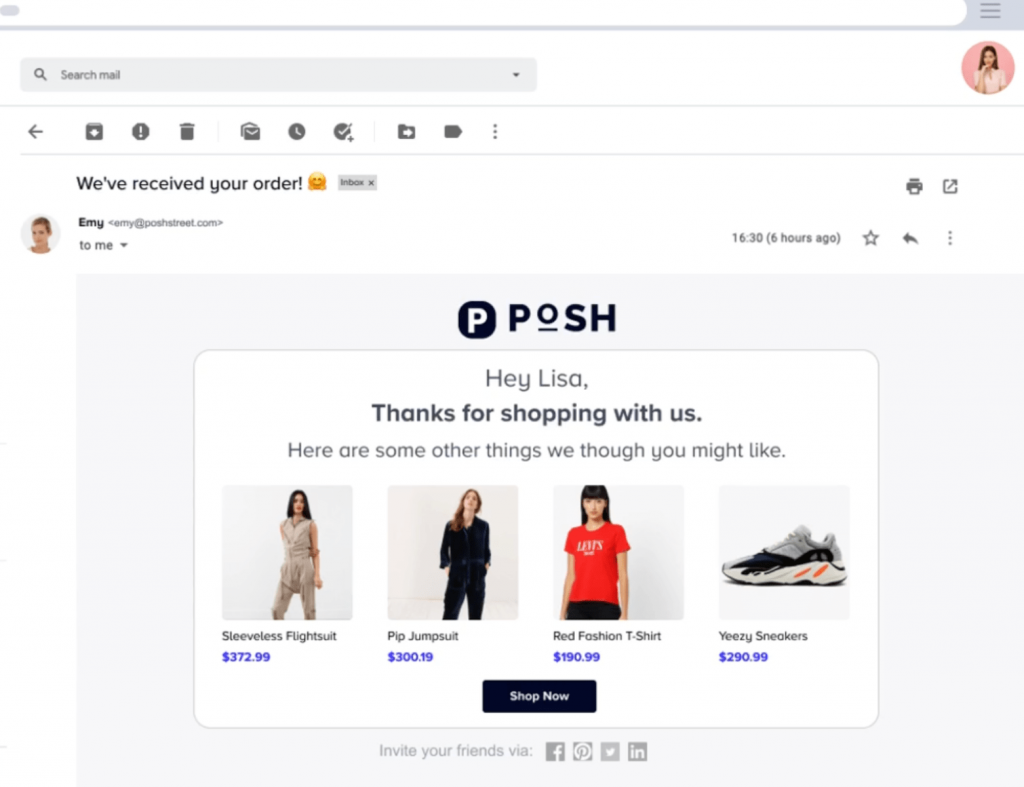
- Push notifications. As we showed earlier, push notifications are incredibly useful in a variety of scenarios, like bringing back cart or browser abandoners and engaging customers with relevant offers while they’re browsing your site. That’s why Insider supports a wide range of web and mobile app push notification types — including recurring ones, price and in-stock alerts, carousels, sliders, and more.

- Messaging channels. SMS, Facebook Messenger, WhatsApp, and other messaging channels can be extremely effective for a variety of goals. For example, with Insider, you can use these channels to send personalized product suggestions, purchase confirmations, and event reminders. You can also have two-way conversations and create end-to-end shopping experiences inside WhatsApp.
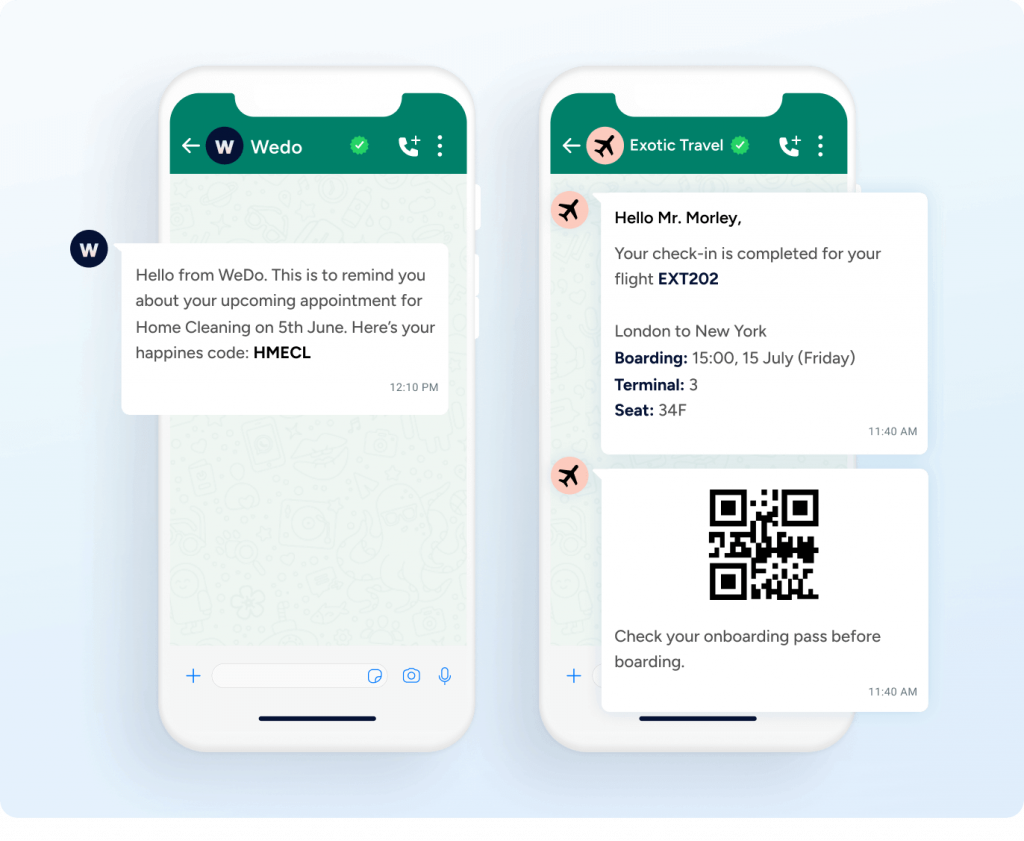
Besides reaching customers on these channels, our platform also lets you build and automate consistent omnichannel journeys with Architect — a versatile customer journey builder and marketing automation solution.
All three companies we looked at earlier used Architect to achieve their omnichannel objectives. As a versatile solution, it enables you to build all sorts of flows and campaigns including:
- Simple email flows that welcome new users and guide them to their first purchase. Remix used this strategy to increase first purchases by 104% compared to the previous quarter.
- Upsell and cross-sell campaigns across email and messaging channels.
- Complex omnichannel journeys for different customer lifecycle stages.
- And much more.

Architect’s AI-powered features also take a lot of work off your plate when it comes to building successful campaigns. For example, it can automatically choose the right times and channels to contact each customer.

If you’re interested, we explore more of Architect’s capabilities and additional omnichannel strategies in our guides to:
Create personalized, high-converting omnichannel experiences with Insider
Insider is an ideal omnichannel customer engagement platform for mid-sized and enterprise brands looking to create, automate, and personalize their omnichannel marketing campaigns.
Our solution has been ranked as the top omnichannel marketing platform by IDC.

As an enterprise marketing platform, Insider can:
- Aggregate your customer data from all online and offline sources into a central database.
- Create detailed 360-degree profiles of your customers and reveal their behaviors, interests, and preferred touchpoints.
- Enable you to analyze your target audiences and their behaviors when it comes to completing key goals, interacting on various channels, buying certain products, and more.
- Segment your customer base and predict future behaviors, like how much they’re projected to spend and how likely they are to buy or engage with your brand on a specific channel.
- Create consistent brand experiences across all channels and at scale, so you can improve key metrics like conversions, revenue, and customer retention.
- Use the full power of AI and machine learning to automate tasks around omnichannel campaign creation and management, such as choosing the right channels and moments to engage customers, generating copy and images, and more.
Schedule a demo with our team to learn how Insider can benefit your business specifically.

